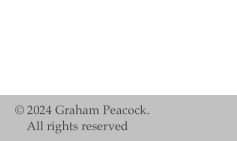 |
 |
||||
All done by rake, roller and scraperJean Richards, The Edmonton Journal. May 29, 1976 A grass rake, a floor brush and a cattle trough are not the usual tools also dated with an artist, yet in the hands of Graham Peacock-they are a very practical means of painting. Peacock's exhibition, at Latitude 53 Gallery, needs mote than a quick loon. His work is literally raked on, brushed on, too, with large floor brushes, and worked over with a series of rollers, and scrapers of all kinds and sires. A horse trough (or galvanized bathtub used in the country) serves as a container for paint, as yell as a suitable place to mix colors. Some of the colors are mixed in large tins. The paint is spread on his canvas which is tacked on the floor (yards and yards of it at a time). Each area is carefully color co-ordinated, but beyond that, the product at the tints of painting is accidental. The acrylic is applied in different dilutions and incised by the stiff bristles of floor brushes and wire rake:-, to rive his distinctive linear effect. Lumps of paint (impastos) are built up as he wishes This drawing in or scratching out is an important part as it begins to make the composition cohesive. Since he covers such wide spaces, his tools have to be larger than the conventional artists' brushes. Also, as he moved from one end of his giant canvas strips, he had to build a "wagon" in which he keeps his tools. Once the canvas is covered to his satisfaction, he then begins the critical part - the cropping out of paintings from the whole. Though the entire process may sound relatively simple, in actual fact it is exceptionally demanding. and this selection especially so, as it must fit with his basic concept or else the paintings would become nothing but decorations. He must be certain that what he chooses shows his thought processes to best advantage. This technique is not new. New York painters often use this method, but the development of ideas must be individual, and original with each artist. Peacock admits being influenced by Poons and Olitsky, yet his work to my mind, has distinctly regional characteristics, and seems to be developing a definite Canadian quality, perhaps by the use of our muted coloration in this area.Graham Peacock was born in London, Erg., but has been in Canada since 1969. He lives and works in Edmonton, teaching at the University of Alberta, department of art and design.As I mentioned, the tools he uses are large and unwieldy, but his paintings are low-key, and quite gently.He leaves edges unpainted, stains in some underpaintings in brilliant color, then brushes over them with soft off-shades. The works in this exhibition have a special quality if you take the time to really look into them. They are not for the casual observer, nor those who are traditionalists. But if you enjoy nonobjective art at its best then these are a real pleasure. This show will be at Latitude 53 Gallery until June |
|||||